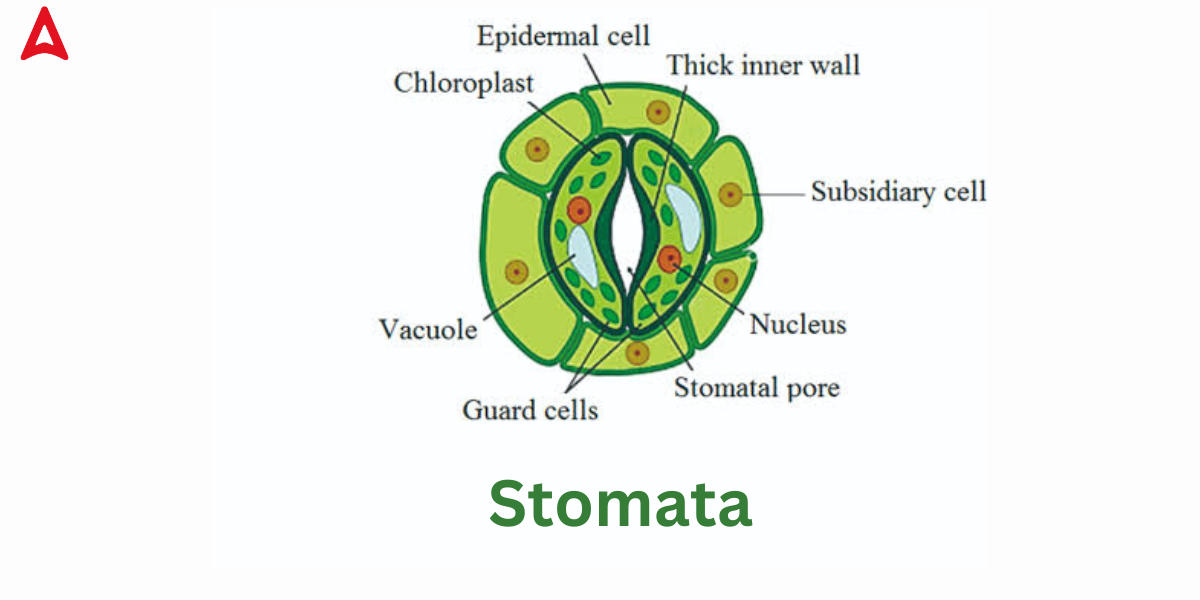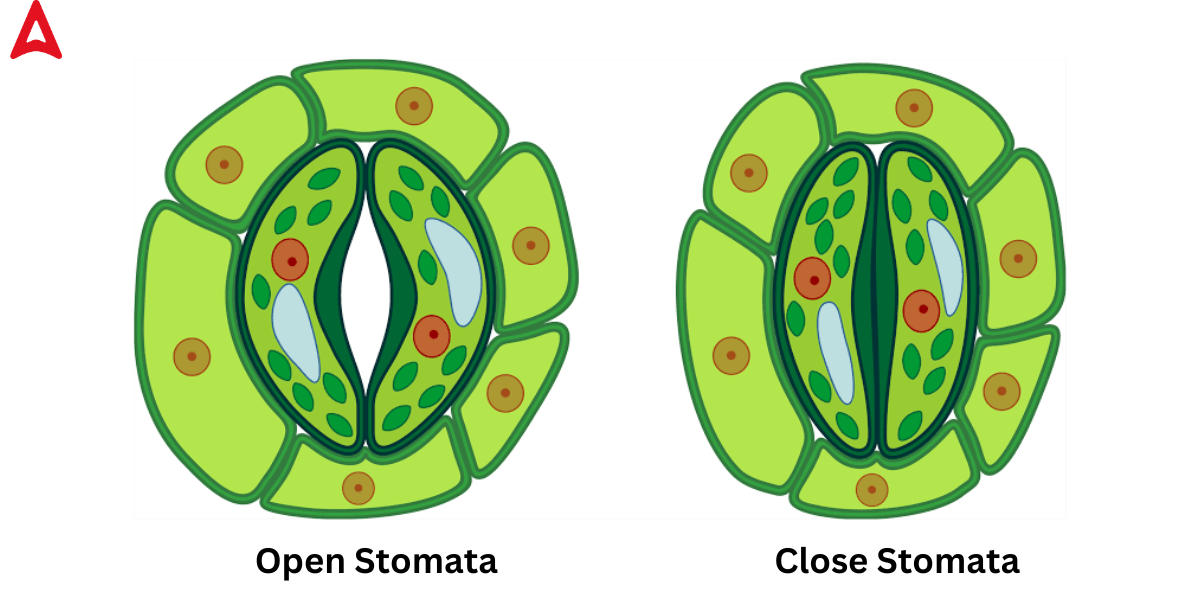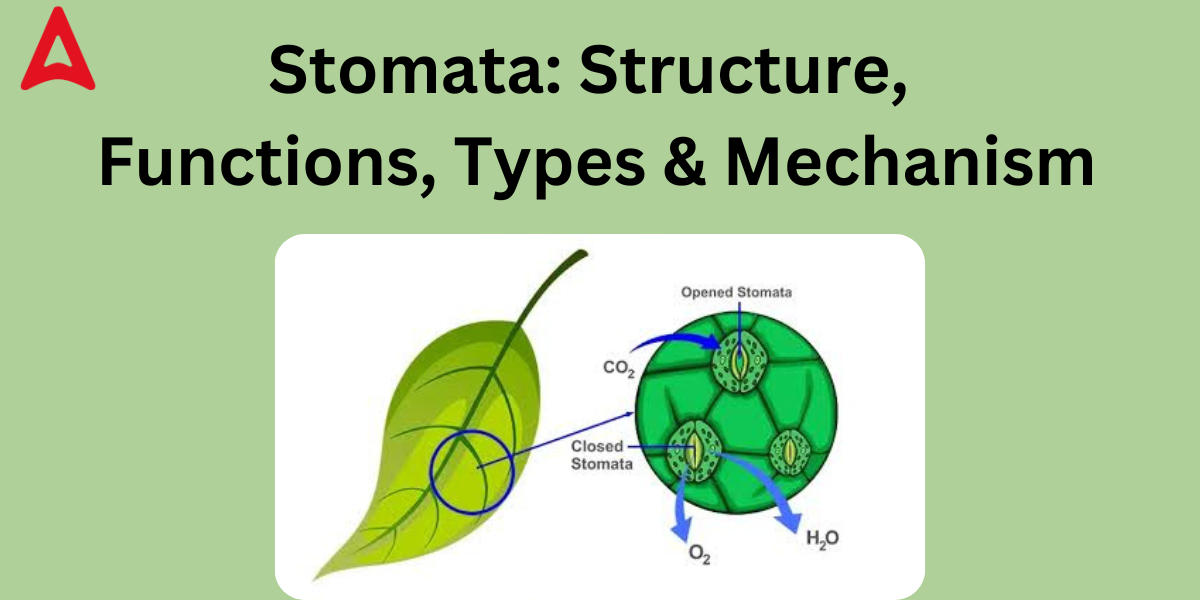Table of Contents
Stomata
Stomata: In green plants, Stomata is one of the most crucial parts, the play vital in the Photosynthesis process. Stomata is a tiny hole in the surface of a leaf that is used for gas exchange. There are thousands of stomata on the surface of the leaves. The majority of them are found on the underside of the leaves. The bulk of the leaves have these microscopic holes, which allow plants to absorb CO2 for photosynthesis and expel waste oxygen. In this post, we will study Stomata – Characteristics, Structure, Types, Mechanism of Stomata Opening and Closing, and Stomata Functions will help us grasp the topic better.
Stomata Definition
Stomate, also known as stoma, plural stomata, or stomas, is any of the microscopic apertures that constitute the most important procedure for a plant’s life. Now the question arises “where is the stomata located?” The stomata are single pores present in the epidermis of the plant’s leaves, stems, and other organs. Stomata are microscopic holes on the surface of green plants that participate in the exchange of water and carbon dioxide between the plant and its surroundings. There are thousands of microscopic stomata on the surface of the leaf during the transpiration and photosynthesis processes, which are carried out by well-defined structures and methods.
Stomata Diagram
“stomata” are the pores that are present, typically on the underside of a plant’s leaves, and that permit the exchange of the gases oxygen and carbon dioxide. Guard cells are specialized cells that surround stomata and operate to open and close stomatal holes. Check out the diagram of the stomata below.

Stomata in Leaves Structure
Stomata are made up of a kidney-shaped epidermal cell with an opening in the center called a pore. Every Stoma pore has a similar structure. The morphology of the cells may vary to some extent, but the process and composition stay constant. The four essential components of a stoma are Pores, Guard cells, Subsidiary cells, and Epidermal cells.
Pores: The primary aperture through which all gaseous exchanges, vapor exchanges, and atmospheric absorption occur is the pore. All of the stomata’s functions would be entirely useless without the pores.
Guard Cells: Guard cells are a pair of specialized parenchyma cells that surround the stomata. The pore is surrounded by a strong and flexible cell wall. The morphology of guard cells varies between monocots and dicots, but the mechanism remains the same. Guard cells have chloroplasts and are bean-shaped. They have chlorophyll and absorb light energy.The guard cells control the size of the opening and closing, protecting the plant from water loss.
Subsidiary Cells: The guard cells are surrounded by the subsidiary cells. They are located in the plant epidermis and serve as guard cells’ auxiliary cells. They guard epidermal cells when guard cells enlarge during stomatal opening because they are situated between guard cells and epidermal cells.
Epidermal cells: Epidermal cells are the building blocks of plants that are irregular in shape and constitute the plant’s outermost layer. These are plant cells that provide physical and mechanical support to the plant. Because they are rigid, they allow the stomatal pores to close again.

Stomata Function
Stomata are minute pores on the surface of green plants that exchange water and carbon dioxide with the surrounding environment. Aside from gaseous exchange, Stomata play the following important activities in a living plant.
Gaseous exchange: Stomatal opening and closure aid in gaseous exchange between the plant and its surroundings. This crucial function of Stomata involves the absorption of carbon dioxide. Stomata allow carbon dioxide uptake and oxygen release during the photosynthesis process.
Transpiration: It aids in transpiration and the elimination of surplus water in the form of water vapor. They also aid in reducing water loss by closing when the weather is hot or dry. Stomata close at night to prevent water from escaping through their pores.
Photosynthesis: Stomata are required for photosynthesis, which is the process by which plants convert sunlight, water, and carbon dioxide into glucose and oxygen. The intake of carbon dioxide through the stomata allows plants to carry out this critical activity, which is essential for their growth, development, and carbohydrate generation.
Control of Leaf Temperature: Stomata also help to regulate leaf temperature. Water vapor is produced through transpiration when the stomata open, resulting in evaporative cooling of the leaves. It regulates the moisture balance based on the weather by opening and closing. This procedure aids in the prevention of overheating and the maintenance of appropriate temperatures for photosynthesis and other metabolic activities.
Types of Stomata
The pore of the Stomata is surrounded by two highly specialized cells and the guard cells. According to their quantity and the features of the surrounding subsidiary cells, Stomata are broadly categorized into five categories. These types of stomata are listed below.
- Anomocytic Stomata
They are surrounded by epidermal cells, which have a fixed form and size. Stomata appear to be embedded in epidermal cells. There is no set number or arrangement of cells surrounding the stomata.
- Anisocytic Stomata
Stomata are anisocytosis, with guard cells sandwiched between two bigger and one considerably smaller subsidiary cell. Stomata are surrounded by three secondary cells of varying sizes, with one being smaller than the other two.
- Anomocyte:
Guard cells surround stomata, which are made up of cells that are the same size, shape, and arrangement as the rest of the epidermal cells.
- Diacritic stomata
Diacritic stomata feature guard cells flanked by two auxiliary cells, each enclosing one end of the opening and meeting opposite the opening’s center.The stomata are encircled by a pair of subsidiary cells that run perpendicular to the guard cell.
- paracytica Stomata
The stomata are encircled by two subsidiaries that run parallel to the stomatal pore and guard cells.
Opening and Closing of Stomata with Diagrams
The mechanism of stomatal opening and closure is dependent on turgor pressure, which is created by the osmotic movement of water in the guard cells. The walls of the stomatal pore’s guard cells are thicker on the outside and thinner on the inside. Stomata open and close depending on whether guard cells are turgid or flaccid.
The primary source of stomatal opening is light. Stomata typically open when light touches the leaf and close at night. During the night, when the light touches the leaf, the stomata open and close.
During the day, the content of carbohydrates rises owing to photosynthesis (guard cells have chloroplast), resulting in the osmotic uptake of water by the guard cells. guard cells expand owing to water inflow, widening the stomatal opening. When the osmotic pressure of the guard cells drops (during the night), water leaves these cells via exosmosis and travels to neighboring epidermal cells with larger concentrations of cell sap.

Stomata Function in Photosynthesis
stomata Play a vital role in the event of Photosynthesis that permit the exchange of the gases oxygen and carbon dioxide. Photosynthesis is the most fundamental process that plants use to stay alive. This is how plants produce oxygen and produce food for themselves by using water, carbon dioxide, and sunlight. Now, this process is a complicated network comprising numerous interconnected processes. Without the presence of stomata in plants, this is not feasible.
Carbon dioxide is a fundamental raw element for photosynthesis that enters the plant through the stomata. Stomata closing and opening aid in the exchange of gases between the plant and its surroundings. It makes it easier for carbon dioxide to enter the plant and oxygen to leave the plant.





 NEET Marks vs Rank 2025, Check NEET Perc...
NEET Marks vs Rank 2025, Check NEET Perc...
 [Live Update] NTA CUET PG Answer Key 202...
[Live Update] NTA CUET PG Answer Key 202...
 MP Board Result 2025 Class 10th, 12th An...
MP Board Result 2025 Class 10th, 12th An...










